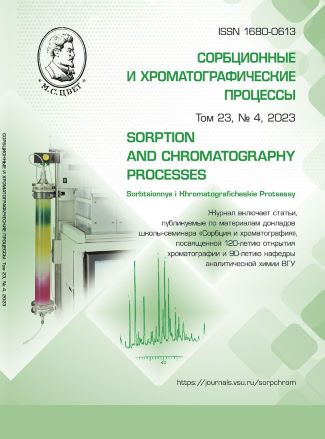Influence of the structure of imidazolium ionic liquids on the chromatographic behaviour of some flavonoids under RP HPLC conditions
Abstract
Flavonoids are the most common natural polyphenolic compounds of complex structure, possessing a wide range of biological activities. The determination of the qualitative and quantitative composition of complex mixtures of biologically active compounds (BAC) is an urgent problem of the pharmaceutical industry. The most suitable and used method for this task is reverse phase high performance liquid chromatography (RP HPLC). To increase the efficiency and selectivity of separation of the mixture, additives of various organic substances are introduced into the aqueous-organic eluent. In this study we investigated the effect of adding certain imidazolium ionic liquids (ILs) into the mobile phase on the chromatographic behaviour of a mixture of (+)-catechol hydrate, rutin, hesperidin, and quercetin under RP HPLC conditions. 1-Butyl-3-methylimidazolium bromide [C4MIM][Br], 1-hexyl-3-methylimidazolium bromide [C6MIM][Br], 1-decyl-3-methylimidazolium bromide [C10MIM][Br], 1-methyl-3-octylimidazolium bromide [MC8IM][Br] and 1-butyl-2,3-dimethylimidazolium tetrafluoroborate [C4dMIM][BF4]. It was shown that the order of release of flavonoids does not change depending on the nature of the IL. It has been established that when IL is added to the eluent, the value of the flavonoid retention factor changes. Addition of IL with long alkyl substituents in the imidazole ring ([C10MIM][Br] and [MC8IM][Br]) led to increased retention of flavonoids (with the exception of the highly polar molecule hesperidin). This is explained, firstly, by the possibility of the formation of a hydrophobic ion pair between the analyte molecule and the IL, secondly, by the implementation of the ion exchange mechanism of molecular retention, and thirdly, by a change in the ionic strength of the mobile phase and an increase in the hydrophobic effect. IL with shorter substituents are not prone to such interactions. The ambiguous effect of imidazolium IL on the efficiency of the chromatographic process has been shown: for each sorbate, a different effect of addition of IL to the aqueous-acetonitrile eluent was observed. Chromatographic system with [C4dMIM][BF4] allows to increase efficiency for the three studied flavonoids - catechin, rutin, and quercetin.
Downloads
References
Kurkin V.A., Kurkina A.V., Avdeeva E.V. Flavonoidy kak biologicheski aktivnye soedinenija lekarstvennyh rastenij, Fundamental'nye issledovanija. 2013; 11-9: 1897-1901.
Panche A.N., Diwan A.D., Chandra S.R., Flavonoids: an overview, Journal of nutritional science. 2016; 5: e47. https://doi.org/10.1017/jns.2016.41
Dias M.C., Pinto D.C.G.A., Silva A.M.S., Plant flavonoids: Chemical characteristics and biological activity, Molecules. 2021; 26(17): 5377. https://doi.org/10.3390/molecules26175377
Yadrova A.A., Grinevich O.I., Shafigulin R.V., Nesterova N.V., Bulanova A.V. The effect of the ionic liquids’ nature on sorption of the benzimidazole and some of its derivatives from aqueous-acetonitrile solutions on octadecyl silica gel, Sorbtsionnye I Khromatograficheskie Protsessy. 2020; 20(6): 674-686. https://doi.org/10.17308/sorpchrom.2020.20/3135
Saifutdinov B.R., Buryak A.K. On the Differences in the Mechanisms of Adsorption of Aromatic Heterocycles from Water-Acetonitrile Solutions on Octadecyl-Bonded Silica Gels, Colloid Journal. 2019; 81(5): 555-562. https://doi.org/10.1134/S1061933X19050107
Civadze A.Ju. Ctrukturnaja samoorganizacija v rastvorah i na granice razdela faz. Moskva, LKI, 2008, 544 p.
Deineka V.I., Deineka L.A., Blinova I.P., Kostenko M.O., Oleinitz E.Yu. About chromatographic behavior of flavonoids in reversed-phase HPLC, Sorbtsionnye I Khromatograficheskie Protsessy. 2016; 16(3): 377-383.
Dmitrienko S.G., Stepanova A.V., Kudrinskaya V.A., Apyari V.V. Specifics of separation of flavonoids by reverse phase high performance liquid chromatography on the Luna 5u C18(2) column, Moscow University Chemistry Bulletin. 2012: 67: 254-258. https://doi.org/10.3103/S0027131412060041
Tang Y., Sun A., Liu R., Zhang Y. Simultaneous determination of fangchinoline and tetrandrine in Stephania tetrandra S. Moore by using 1-alkyl-3-methylimidazolium-based ionic liquids as the RP-HPLC mobile phase additives, Anal. Chim. Acta. 2013; 767: 148-154. https://doi.org/10.1016/j.aca.2013.01.001
Kartsova L.A., Bessonova E.A., Kolobova E.A. Ionic liquids as modifiers of chromatographic and electrophoretic systems, Journal of Analytical Chemistry. 2016; 71(2): 141-152. https://doi.org/10.1134/S1061934816020064
García-Alvarez-Coque M.C., Ruiz-Angel M.J., Berthod A., Carda-Broch S. On the use of ionic liquids as mobile phase additives in high-performance liquid chromatography. A review, Anal. Chim. Acta. 2015; 883: 1-21. https://doi.org/10.1016/j.aca.2015.03.042
Axente R.E., Stan M., Chitescu C.L., Nitescu V.G., Vlasceanu A.M., Baconi D.L. Application of Ionic Liquids as Mobile Phase Additives for Simultaneous Analysis of Nicotine and Its Metabolite Cotinine in Human Plasma by HPLC–DAD, Molecules. 2023; 28(4): 1563. https://doi.org/10.3390/molecules28041563
Cui G., Yu H., Ma Y.J. Ionic liquids as mobile phase additives for determination of thiocyanate and iodide by liquid chromatography, J. Sep. Sci. 2019; 42(9): 1733-1739. https://doi.org/10.1002/jssc.201801277
Welton T. Room-Temperature Ionic Liquids. Solvents for Synthesis and Catalysis, Chem. Rev. 1999; 99(8): 2071-2084. https://doi.org/10.1021/cr980032t
Ruiz-Ángel M.J., Carda-Broch S., García-Álvarez-Coque M.C. Ionic liquids as mobile phase additives and immobilized on stationary phases in liquid chromatography. Ionic Liquids in Analytical Chemistry. Elsevier, 2022; 203-234. https://doi.org/10.1016/B978-0-12-823334-4.00003-5
DrugBank. Available at: https://go.drugbank.com/ (accessed: 01 August 2023).
Chemical Book. Available at: https://www.chemicalbook.com/ (accessed: 01 March 2023).
LabNetwork. Available at: https://www.labnetwork.com/ (accessed: 01 March 2023).
Wang X, Zhang S, Yao J, Li H. The polarity of ionic liquids: relationship between relative permittivity and spectroscopic parameters of probe, Ind. Eng. Chem. Res. 2019; 58(17): 7352-7361. https://doi.org/10.1021/acs.iecr.9b00485







